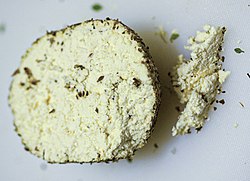Types of cheese
Some of the most common types of cheese from the Levant are:
Akkawi

Akkawi (also called akawi, akkawi, and akawieh) is a white cheese with a rich and subtle flavor. It is an Levantine cheese originating from the Akka (Akka in Arabic). This cheese is commonly made using pasteurized cow's milk but can be made with goat or sheep's milk. It is produced on a large scale in Israel, Jordan, Syria and Palestine. [2] Akkawi cheese is used in such dishes as Manakish (a flatbread topped with cheese, seeds and oil), Sambusek, Kunafa (a dessert cooked from shredded phyllo dough, stretchy cheese and soaked in cane sugar syrup), Mana'eesh (a Palestinian pastry stuffed with cheese and dried mint) and Fatayer (a Levantine meat pie).
Baladi
Baladi cheese is a soft-white, smooth, creamy cheese with a mild yet rich flavour, usually spread on fresh bread or crackers and most often eaten for breakfast or snacks. Baladi cheese is fresh, traditionally unpasteurized, and uncultured and is made with a mixture of goat, cow and sheep's milk. The presence of microorganisms and factors such as high moisture, being uncultured and unpasteurized tend to limit shelf life to just three days. [3]
Circassian
It is a cheese made across the Caucasus (Armenia, Azerbaijan, Georgia and parts of Russia) by the Circassian people. Circassian cheese is made with raw cow, sheep and/or goat's milk, while Adyghean cheese is made only with cow's milk. Circassian and Adyghean cheese are both made by producing curdles, which is achieved by adding acid to raw milk. The curdles don't melt even when exposed to high temperatures. There is also a 'smoked' version of this cheese. It is a tradition to compete to make the best type of Circassian cheese in Maykop, the capital of the Republic of Adyghea.
Jibneh Arabieh

Jibneh Arabieh (Arabic for "Arab cheese") is also referred to as jibneh baida ("white cheese"). It is found throughout the Middle East and is particularly popular in Egypt and Eastern Arabia. It is a fresh cheese with a milky quality, a pronounced saltiness, medium-firmness, and excellent meltability. It can also be boiled before eating. While the product originated with Bedouins using goat or sheep milk, the current practice is to use cow's milk and to add mahleb, a spice ground from pits of the Prunus mahaleb cherry for a "slightly salty, sweet and nutty” flavor. [4] Jibneh Arabieh is used in cooking or simply as a table cheese (A table cheese is a cheese that can be paired with a variety of foods and wines, and served with appetizers, soups, salads, main courses, and desserts). [5] [6] [7]
Majdoule
Majdoule [(or, madjoul) means “braided” in Arabic] originates from Armenia and is incredibly popular for centuries and considered a culturally Syrian food [ mainly in ] Northern Syria. It is a salty white string cheese made up of thick strands braided together. It can be used in grilled cheese, sandwiches, eaten as a snack or after adding to Lebanese and pita bread and used for melting too. [8]

Nabulsi
Nabulsi cheese is a semi-hard cheese made primarily from sheep milk with goat milk being an alternative. It has a dense texture and melts easily. This cheese can be either salted or unsalted and is made from pasteurized milk from sheep, goats, or camels. It is also used as a base for other sweet-cheese desserts such as knafeh where it is almost always used. [1] [9] [10]
Shelal
Shelal (also known as mshalshe) is a brined, white string cheese made up of strands woven together. It is used mainly in savoury dishes in the Levant. [11]


Surke
Surke (also called sorke or shanklish) is a matured cheese made with spices and generally presented as balls covered in za'tar orchile powder or other dry herbs (thyme, oregano, garlic, and/or chili pepper). [1] It is most often eaten as a starter dish with tomato, oil, and sometimes onion. [12]
Jibneh Mshallale
Jibneh mshallale (or 'braided' cheese) is a form of string cheese originating in Syria. It is a fresh cheese, typically made from a combination of milks from cows, sheep, or goats. It is a cross between mozzarella, feta and halloumi (a cheese from the Cyprus that has a tangy taste and a firm, chewy texture). [13]
Turkoman
Turkoman cheeses (Tulum, Kasar, Divle Obruk, Cevizli tulum) are soft, porous cheeses with a delicate flavor which can be consumed fresh or aged in bags made from animal skins. Turkoman cheeses are made with sheep milk or non-fat cow milk.